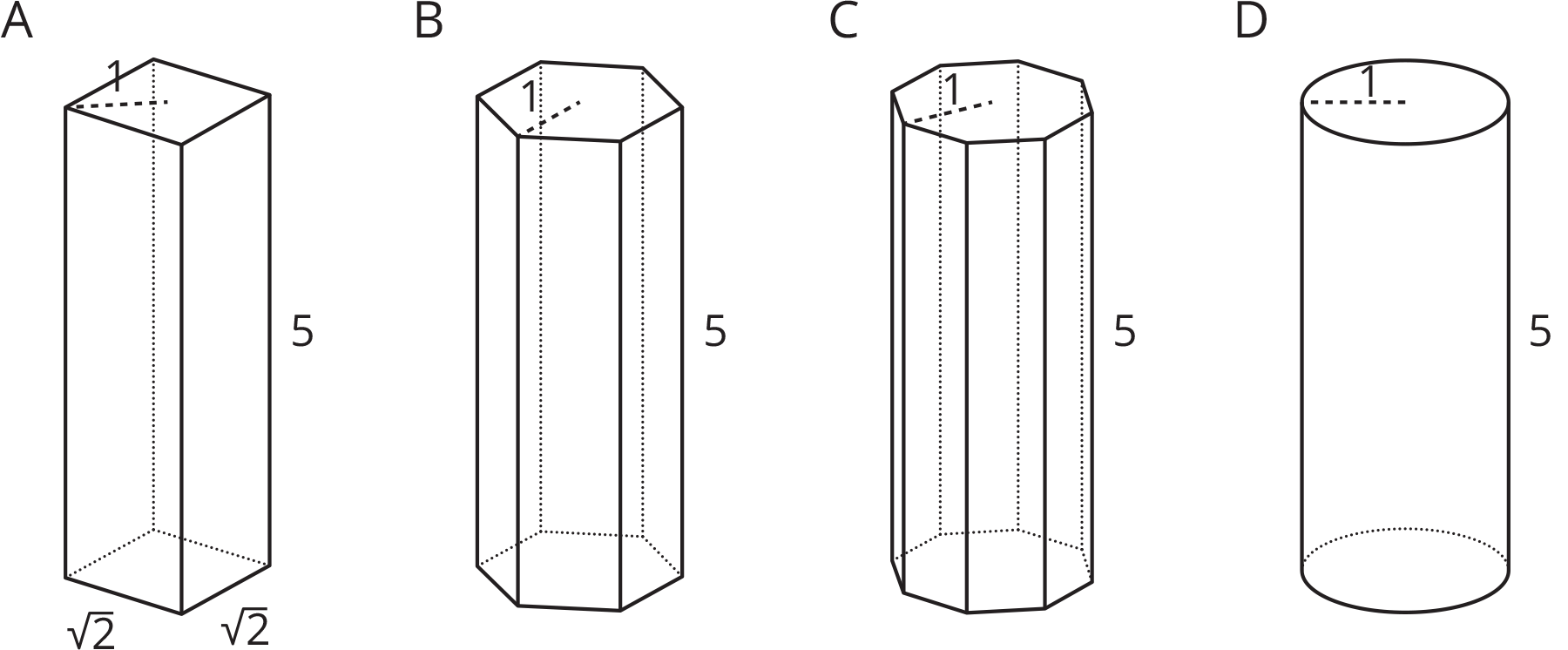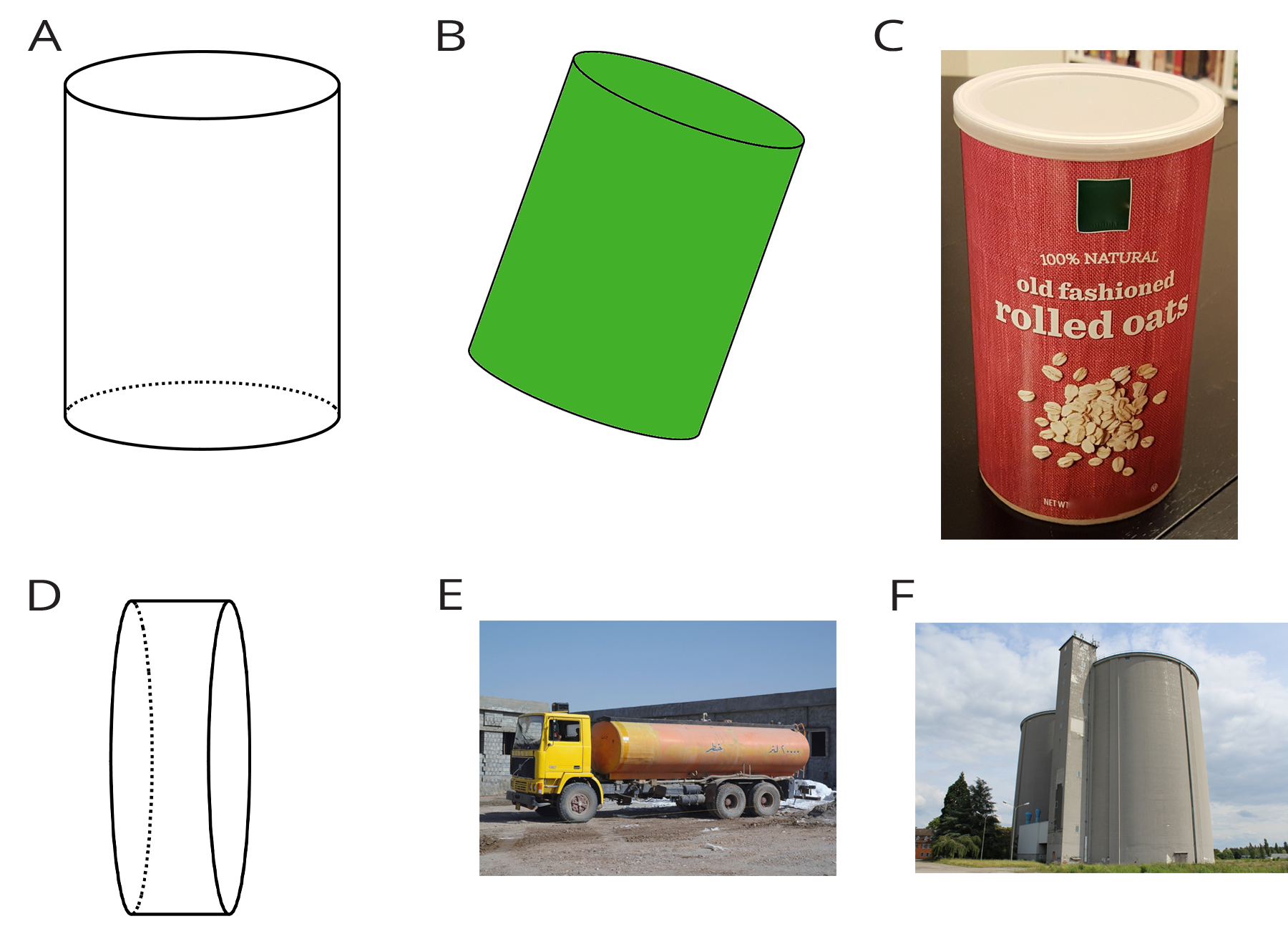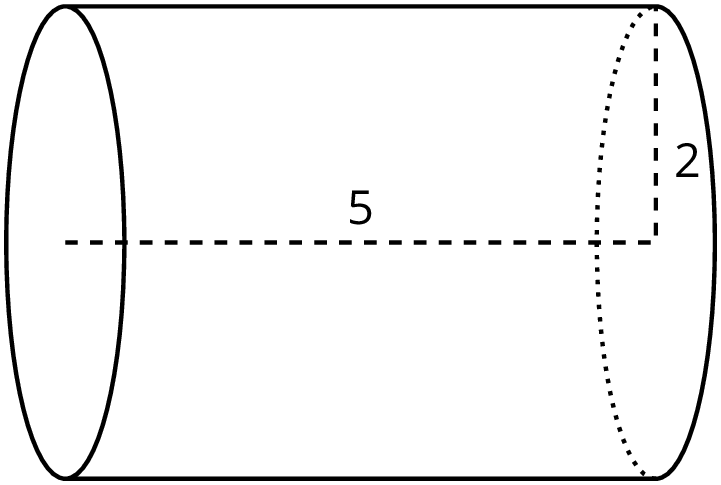Lesson 13
The Volume of a Cylinder
13.1: A Circle's Dimensions (10 minutes)
Warm-up
The purpose of this warm-up is for students to review how to compute the area of a circle. This idea should have been carefully developed in grade 7. This warm-up gives students an opportunity to revisit this idea in preparation for finding the volume of a cylinder later in the lesson.
Students begin the activity with a whole-class discussion in which they identify important features of a circle including its radius and diameter. They use this information and the formula for the area of the circle to choose expressions from a list that are equivalent to the area of the circle. In the final question, students are given the area of the circle and find the corresponding radius.
As students are working, monitor for students who can explain why \(16\pi\), \(\pi 4^2\), and “approximately 50” square units represent the area of the circle.
Launch
Display the diagram from the task statement for all to see and ask students:
- “Name a segment that is a radius of circle A.” (AC, AD, and AB or those with the letters reversed are all radii.) Review the meaning of the radius of a circle.
- “What do we call a segment like BC, with endpoints on the circle that contains the center of the circle?” (A diameter.) Review the meaning of a diameter of a circle.
- “What is the length of segment \(AB\)?” (4 units.) Review the fact that all radii of a circle have the same length.
Give students 3 minutes of quiet work time and follow with a whole-class discussion.
Student Facing

Here is a circle. Points \(A\), \(B\), \(C\), and \(D\) are drawn, as well as Segments \(AD\) and \(BC\).
- What is the area of the circle, in square units? Select all that apply.
- \(4\pi\)
- \(\pi 8\)
- \(16\pi\)
- \(\pi 4^2\)
- approximately 25
- approximately 50
- If the area of a circle is \(49\pi\) square units, what is its radius? Explain your reasoning.
Student Response
For access, consult one of our IM Certified Partners.
Anticipated Misconceptions
If students struggle to recall how to find the area of a circle, encourage them to look up a formula using any available resources.
Activity Synthesis
The purpose of this discussion is to make sure students remember that the area of a circle can be found by squaring its radius and multiplying by \(\pi\).
Select previously identified students to share answers to the first question and explain why each of the solutions represents the area of the circle. If not brought up during the discussion, tell students that sometimes it is better to express an area measurement in terms of \(\pi\). Other times it may be better to use an approximation of \(\pi\), like 3.14, to represent the area measurement in decimal form. In this unit, we will often express our answers in terms of \(\pi\).
Display in a prominent place for all to see for the next several lessons: Let \(A\) be the area of a circle of radius \(r\), then \(A=\pi r^2\).
13.2: Circular Volumes (15 minutes)
Activity
The purpose of this activity is for students to connect their previous knowledge of the volume of rectangular prisms to their understanding of the volume of cylinders. From previous work, students should know that the volume of rectangular prisms is found by multiplying the area of the base by the height. Here we expand upon that to compute the volume of a cylinder.
Students start by calculating the volume of a rectangular prism. Then they extrapolate from that to calculate the volume of a cylinder given the area of its base and its height. If some students don’t know they should multiply the area of the base by its height, then they are prompted to connect prisms and cylinders to make a reasonable guess.
We want students to conjecture that the volume of a cylinder is the area of its base multiplied by its height.
Launch
Arrange students in groups of 2. Remind students that a rectangular prism has a base that is a rectangle, and a cylinder has a base that is a circle. It may have been some time since students have thought about the meaning of a result of a volume computation. Consider showing students a rectangular prism built from 48 snap cubes with the same dimensions as Figure A. It may help them to see that one layer is made of 16 cubes. Give students 3–5 minutes of quiet work time followed by a partner discussion. During their discussion, partners compare the volumes they found for the cylinders. If they guessed the volumes, partners explain their reasoning to one another. Follow with a whole-class discussion.
Supports accessibility for: Visual-spatial processing; Conceptual processing
Student Facing
What is the volume of each figure, in cubic units? Even if you aren’t sure, make a reasonable guess.

- Figure A: A rectangular prism whose base has an area of 16 square units and whose height is 3 units.
- Figure B: A cylinder whose base has an area of 16\(\pi\) square units and whose height is 1 unit.
- Figure C: A cylinder whose base has an area of 16\(\pi\) square units and whose height is 3 units.
Student Response
For access, consult one of our IM Certified Partners.
Student Facing
Are you ready for more?
| prism | prism | prism | cylinder |
| base: square | base: hexagon | base: octagon | base: circle |

Here are solids that are related by a common measurement. In each of these solids, the distance from the center of the base to the furthest edge of the base is 1 unit, and the height of the solid is 5 units. Use 3.14 as an approximation for \(\pi\) to solve these problems.
- Find the area of the square base and the circular base.
- Use these areas to compute the volumes of the rectangular prism and the cylinder. How do they compare?
- Without doing any calculations, list the figures from smallest to largest by volume. Use the images and your knowledge of polygons to explain your reasoning.
- The area of the hexagon is approximately 2.6 square units, and the area of the octagon is approximately 2.83 square units. Use these areas to compute the volumes of the prisms with the hexagon and octagon bases. How does this match your explanation to the previous question?
Student Response
For access, consult one of our IM Certified Partners.
Activity Synthesis
Highlight the important features of cylinders and their definitions: the radius of the cylinder is the radius of the circle that forms its base; the height of a cylinder is the length between its circular top and bottom; a cylinder of height 1 can be thought of as a “layer” in a cylinder with height \(h\). To highlight the connection between finding the area of a rectangular prism and finding the area of a cylinder, ask:
- “How are prisms and cylinders different?” (A prism has a base that is a polygon, and a cylinder has a base that is a circle.)
- “How are prisms and cylinders the same?” (The volume of cylinders and prisms is found by multiplying the area of the base by the height. \(V=Bh\))
- “How do you find the area of the base, \(B\), of a cylinder?” (\(B=\pi r^2\)).
Design Principle(s): Optimize output (for explanation)
13.3: A Cylinder's Dimensions (10 minutes)
Optional activity
In this optional activity, students use colored pencils (or pens or highlighters) to label the radius and height on different pictures of cylinders. Then they sketch their own cylinders and label the radius and heights of those. The purpose of this activity is for students to practice identifying the radius and height of various cylinders, some of which are in context.
This activity can also be abbreviated if students demonstrate prior understanding of how to draw or label cylinders and only need a brief refresh.
Launch
Distribute colored pencils. Give students 1–2 minutes of quiet work time followed by a whole-class discussion.
Student Facing
-
For cylinders A–D, sketch a radius and the height. Label the radius with an \(r\) and the height with an \(h\).

- Earlier you learned how to sketch a cylinder. Sketch cylinders for E and F and label each one’s radius and height.
Student Response
For access, consult one of our IM Certified Partners.
Anticipated Misconceptions
In diagrams D and E, some students might mistake the diameter for the height of the cylinder. Some students may mark a height taller than the cylinder due to the tilt of the figure.
Activity Synthesis
Select students to share where they marked the radius and height and the cylinders sketched for images E and F. Discuss examples of other cylinders students see in real life.
Design Principle(s): Support sense-making; Maximize meta-awareness
13.4: A Cylinder's Volume (10 minutes)
Activity
The purpose of this activity is to give students opportunities to find the volumes of some cylinders. By finding the area of the base before finding the volume, students are encouraged to compute the volume by multiplying the area of its base by its height. This way of thinking about volume might be more intuitive for students than the formula \(V=\pi r^2 h\). Notice students who plug the radius into a formula for the volume and students who find the area of the base and multiply that by the cylinder’s height.
The second problem of this activity focuses on exploring cylinders in a context. Generally, the volume of a container is the amount of space inside, but in this context, that also signifies the amount of material that fits into the space. Students are not asked to find the area of the base of the silo. Notice students that find the area before computing the volume and those that use the volume formula and solve for it directly. Notice at what step in the computations students approximate \(\pi\).
When working with problems in a given context, it is sometimes convenient or practical to use an approximation of \(\pi\). An example of this is given in the question regarding the volume of a grain silo and interpretations of the answer.
Launch
Provide access to colored pencils to shade the cylinder’s base. Give students 5–6 minutes of quiet work time followed by a whole-class discussion.
Supports accessibility for: Language; Conceptual processing
Student Facing
-
Here is a cylinder with height 4 units and diameter 10 units.

- Shade the cylinder’s base.
- What is the area of the cylinder’s base? Express your answer in terms of \(\pi\).
- What is the volume of this cylinder? Express your answer in terms of \(\pi\).
-
A silo is a cylindrical container that is used on farms to hold large amounts of goods, such as grain. On a particular farm, a silo has a height of 18 feet and diameter of 6 feet. Make a sketch of this silo and label its height and radius. How many cubic feet of grain can this silo hold? Use 3.14 as an approximation for \(\pi\).
Student Response
For access, consult one of our IM Certified Partners.
Student Facing
Are you ready for more?
One way to construct a cylinder is to take a rectangle (for example, a piece of paper), curl two opposite edges together, and glue them in place.
Which would give the cylinder with the greater volume: Gluing the two dashed edges together, or gluing the two solid edges together?

Student Response
For access, consult one of our IM Certified Partners.
Anticipated Misconceptions
Students might use the silo’s diameter instead of the radius to find the volume. Remind them of the formula for area of a circle and the discussion about diameter and radius earlier in this lesson.
Activity Synthesis
The goal of this discussion is to ensure students understand how to use the area of the cylinder’s base to calculate its volume. Consider asking the following questions:
- “How does knowing the area of a circular base help determine the volume of a cylinder?” (The volume is this area multiplied by the height of the cylinder.)
- “If the cylinder were on its side, how do you know which measurements to use for the volume?” (Since we need area of the base first, the radius or diameter of the circle will always be the measurement used for \(r\), and the height is always the distance between the bases, or the measurement perpendicular to the bases. It doesn’t matter which direction the cylinder is turned.)
- “When is it better to use approximations of pi instead of leaving it exact?” (Approximating pi helps us interpret an answer that has pi as a factor, like the area of a circular region or the volume of a cylindrical container.)
Design Principle(s): Support sense-making; Optimize output (for explanation)
Lesson Synthesis
Lesson Synthesis
Make a display that includes the formula for a cylinder’s volume, \(V=B h\), along with a labeled diagram of a cylinder. This display should be kept posted in the classroom for the remaining lessons within this unit.
Previously, students computed the volume of prisms by multiplying the area of the base by the prism’s height. To help students summarize the ideas in this lesson, ask “How is finding the volume of a cylinder like finding the volume of a prism?” and give students 2–3 minutes to write a response. Encourage students to use diagrams to show their thinking. Invite students to share their ideas, displaying any diagrams for all to see.
13.5: Cool-down - Liquid Volume (5 minutes)
Cool-Down
For access, consult one of our IM Certified Partners.
Student Lesson Summary
Student Facing
We can find the volume of a cylinder with radius \(r\) and height \(h\) using two ideas we've seen before:
- The volume of a rectangular prism is a result of multiplying the area of its base by its height.
- The base of the cylinder is a circle with radius \(r\), so the base area is \(\pi r^2\).
Remember that \(\pi\) is the number we get when we divide the circumference of any circle by its diameter. The value of \(\pi\) is approximately 3.14.
Just like a rectangular prism, the volume of a cylinder is the area of the base times the height. For example, take a cylinder whose radius is 2 cm and whose height is 5 cm.

The base has an area of \(4\pi\) cm2 (since \(\pi\boldcdot 2^2=4\pi\)), so the volume is \(20\pi\) cm3 (since \(4\pi \boldcdot 5 = 20\pi\)). Using 3.14 as an approximation for \(\pi\), we can say that the volume of the cylinder is approximately 62.8 cm3.
In general, the base of a cylinder with radius \(r\) units has area \(\pi r^2\) square units. If the height is \(h\) units, then the volume \(V\) in cubic units is \(\displaystyle V=\pi r^2h\)